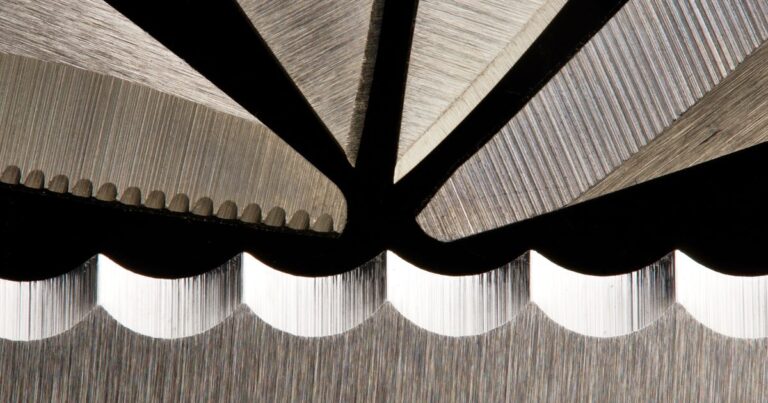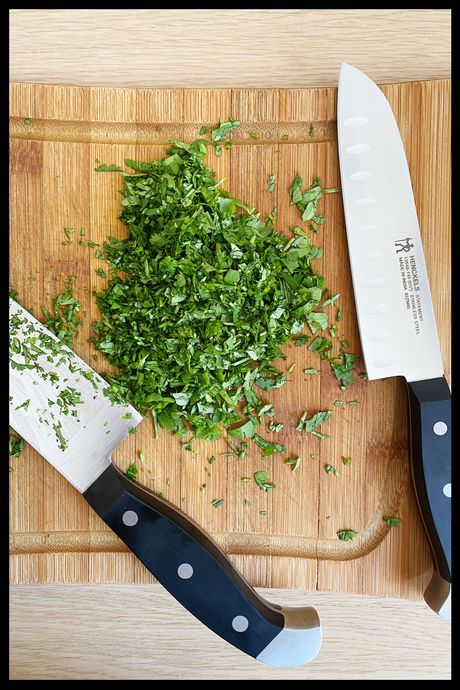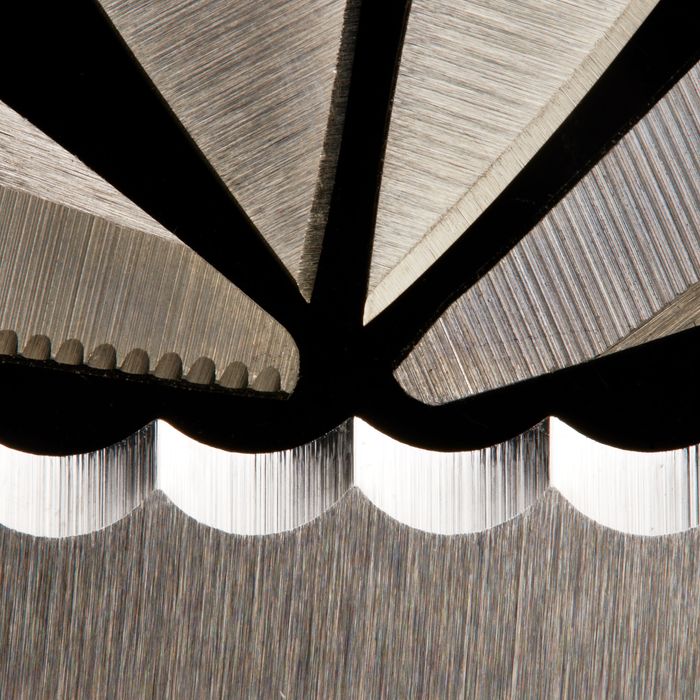
Photo: Marcus McDonald
Buying pre-packaged multiples of cookware and kitchen tools can be tricky: The discounted pricing makes them appealing, but you’ll often end up with unused pieces. When it comes to knife sets specifically, my advice is to assess what you really need before you take the plunge, whether you’re starting completely from scratch, redoing the basics of your collection, or simply want to add a handful of new blades to what you already own — then take your pick from there.
To curate this list, I first took into consideration the backbone of most great groupings: a sharp, durable chef’s knife. With the exception of a couple of speciality packs (like steak knives), every set on this list includes one. It’s the knife you’re likely to turn to most often, and a quality one is a good indication that the others will be well made, too. Indeed, I have an entire guide dedicated to just chef’s knives where you’ll see quite a bit of overlap in brands (from older established makers like Wüsthof and Global to newer DTC companies like Material Kitchen and Made In).
But it’s not as simple as just assessing the major players. I looked at what else was included in the set, tested several myself, and then talked to nearly a dozen experts (chefs, cookbook authors, and recipe testers among them). What results is a purposefully varied curation: three pieces all the way up to 20-something, collections with only the basics, ones that come with sharpening tools or blocks and ones that don’t. I also made sure that none have truly unnecessary pieces — but if you’re unsure, my takeaway after doing this extensive research is that a more streamlined set is generally the way to go. You can always build from there.
Update on July 9, 2024: Updated prices and checked stock for all products.
Knife sets can come with anywhere from three pieces to more than 20. For this story, I (and the experts I spoke to) leaned significantly towards the smaller end of that spectrum. I’m of the opinion that most of the time, it makes sense to buy a smaller core group — a chef’s knife, a paring knife, and a serrated knife — and then assess. Are you always wishing you had a second chef’s knife so you don’t have to clean in between tasks? Does it turn out you’d benefit from a boning knife because you eat fish and chicken multiple days a week? From your core group, you can always add individual implements as you see what your real needs are. Here, I’ve listed the number of pieces in a given set so you can get a sense of size at a glance, then detailed what each one is.
This classification is a bit of a tricky one because not every knife falls distinctly into one category or the other (and some knives don’t fall into either at all). And yet these terms are still commonly used, the distinctions notable enough that it’s good to have a sense of the main characteristics of each — especially when it comes to the chef’s knife in each of these sets. First of all, European-style is kind of a catch-all term that can also be called German-style, French-style, and Western-style. These are generally heavier with a thicker, more curved blade to facilitate rocking back and forth with the tip down on your cutting board. On the other hand, Japanese-style tend to be lighter with a thinner blade and straighter edge to facilitate extreme precision. To make things even more confusing, some Japanese companies make some European-style knives, and some European and American companies make Japanese-style knives. But here I’ve denoted the style of each to the best of my ability, and then gone into more detail in the descriptions.
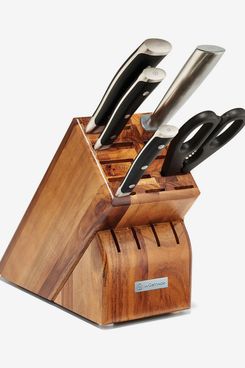
Number of pieces: Six (paring knife, bread knife, chef’s knife, honing steel, kitchen shears, knife block) | Style: European
Wüsthof is a classic company. It’s the one that cook and Top Chef Canada host Eden Grinshpan was told to buy when she was in culinary school, the one that cookbook author Erin Gleeson registered for when she got married a decade ago and still uses, and the one that is preferred by multiple celebrity chefs with varying cooking styles (a quick Google search will tell you that both Ina Garten and Gordon Ramsay swear by them). “They’re just super high-quality and they really stand the test of time,” Grinshpan says. “I still have some of the pieces in my kitchen.”
Given that Wüsthof is so time-tested and such a trusted brand among professionals, I knew they would be a fitting choice for our best overall pick. From there, I perused all their offerings and landed on this particular set for its lineup of pieces, which I think is perfectly well-rounded without being superfluous. It comes with a paring knife, a chef’s knife, and a serrated knife — the only three that you really need when it comes down to performing most cooking tasks, like I explained before. But it also includes some helpful accessories: a wooden block to hold your blades safely, a honing steel to sharpen the edges, and a pair of “come-apart” kitchen shears (the “come-apart” makes them easy to clean). “I use the scissors all the time,” Gleeson says, “for cutting everything from pizza and flatbreads to scallions.”
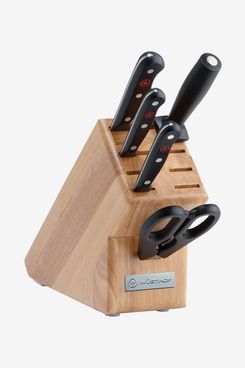
Number of pieces: Six (paring knife, serrated utility knife, chef’s knife, honing steel, kitchen shears, knife block) | Style: European
This more affordable set from Wüsthof has a similar setup. The paring knife is a half-inch smaller (which shouldn’t make any noticeable difference for daily use), the serrated knife is three inches smaller (and intended to cut things like tomatoes, as opposed to crusty bread), and the block is made from a different variety of wood (beechwood instead of acacia). Most notably, though, the knives are stamped (cut from one large sheet of steel) instead of forged (made from a single bar of steel that is heated and then pounded into shape either by hand or machine). This makes them not quite as durable as they would be otherwise, but also much cheaper — and they can totally do the trick (and do it well), especially if you aren’t particularly hard on your knives.
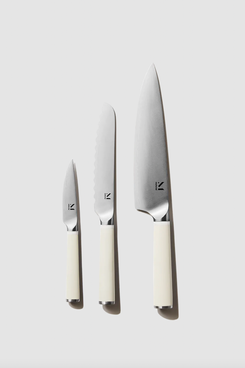
Number of pieces: Three (paring knife, serrated utility knife, chef’s knife) | Style: Japanese
If you don’t think you’ll use all the pieces in the bigger Wüsthof sets above, this one will still have you covered with the three most basic, essential knives — ones that, to my mind, will comfortably take care of pretty much any cutting, chopping, slicing, and dicing you’ll ever need to do. In testing, I found the eight-inch chef’s knife to be comfortable to hold because of the rounded handle shape. It’s also balanced in weight, easy to rock back and forth to dice, as well as slice through hefty vegetables with an assured cut. The edge is super sharp, and though I’ve only been using it for a few months, recipe developer and writer Rebecca Firkser says hers has stayed in great shape for several years. The paring knife has more of a curve than some others in my collection, making it particularly useful for intricate carving and tasks, like hulling strawberries. And notably, the serrated knife — which I think is the standout of the bunch — is significantly shorter than most, at six inches long. It wouldn’t be substantial enough to cut through a round cake layer to even out the surface, but it can handle other tasks like slicing bread and tomato slices with even more control than a super long blade.
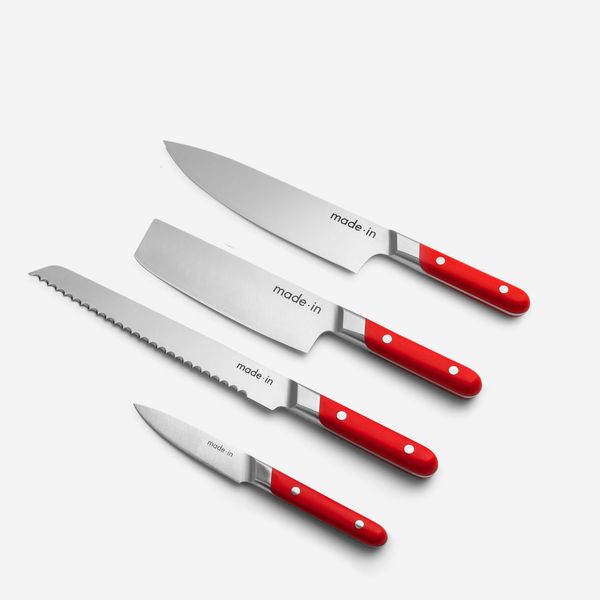
Number of pieces: Four (paring knife, bread knife, chef’s knife, nakiri knife) | Style: European
Made In makes a relatively uncommon combination of knives — the three essentials I mentioned above, plus a nakiri knife, which I have found to be a useful addition. It looks a bit like a small cleaver, but is meant for cutting vegetables with an entirely straight edge. The blade is only six inches (two inches shorter than another nakiri I own that I find too big for nuanced tasks like chopping through cauliflower). This one, on the other hand, gives great control and is still hardy enough to hack away at a squash. I also really like the chef’s knife, which is on the heavier side (eight ounces) without being burdensome. The weight feels good in my hand and helps guide the sharp edge seamlessly through whatever I’m cutting.
Culinary producer Kiano Moju first bought this set when she was stocking her culinary creative studio, a kitchen she needed to outfit from scratch. “They hold really nicely,” she says. “When I was working at Sur La Table years ago, someone taught me how to cut with your thumb on the top of the spine, and it balances nicely if that’s how you use your knives. They’re well balanced, and not too heavy at all. Plus, they’re really cute. They come in red, which is my favorite.”
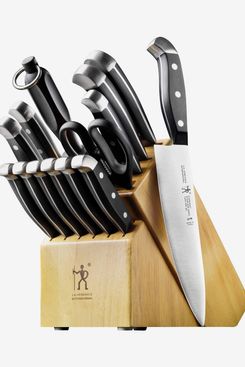

Number of pieces: 15 (paring knife, serrated utility knife, santoku knife, chef’s knife, bread knife, set of six steak knives, honing steel, kitchen shears, knife block) | Style: European
J.A. Henckels, the more affordable sister brand to Strategist-favorite Zwilling (they make a chef’s knife, blender, and nonstick skillet we love), makes an all-encompassing knife set that I think is solid, especially for the price. The most notable feature is six matching serrated steak knives (not usually included in these collections) that I’ve found are excellent at cutting through steak and pork chops without ripping or shredding the meat.
It also includes the essentials: a paring knife, chef’s knife, and bread knife. Plus there’s a santoku knife (similar to a chef’s but slightly smaller and thinner and therefore easier to wield when I perform more complicated tasks with subtler cuts), as well as a shorter serrated knife, perfect for slicing through tomatoes and baked goods. Though I was a bit skeptical of the quality since this is one of three sets on this list where the knives are stamped instead of forged (the others are the Wüsthof Gourmet, above, and the collection of small Opinel knives, below), the handles feel tightly secured to the blades, and overall, they have a nice heft in my hand. They are a bit boxier, and therefore harder to get your palm gripped around in a comfortable position than the more rounded and smooth-edged handles I use regularly — but that seems a small issue for the value you get here.
Photo: Emma Wartzman
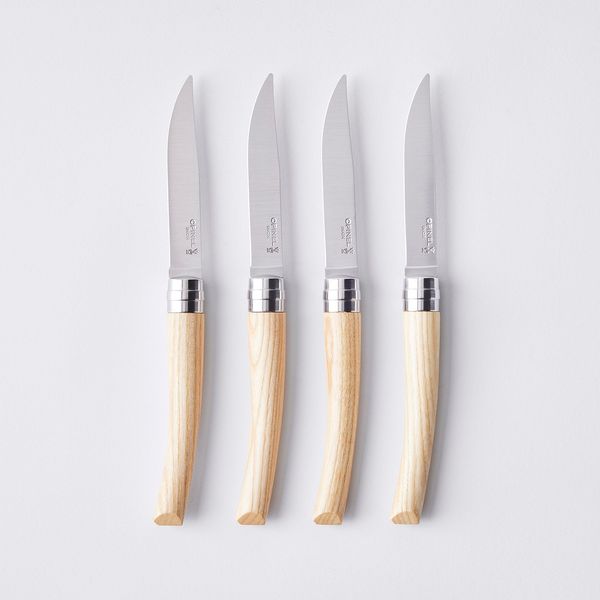
Number of pieces: Four (steak knives) | Style: European
I’ve long been a fan of Opinel’s well-priced, sharp, and elegant knives (you’ll find them in other Strategist stories and their set of paring knives is below). The stainless-steel blades of these have a straight (also called fine) edge, which slices through meat more cleanly than serrated ones I’ve used in the past. (Even if a serrated knife is sharp, you have to saw back and forth a bit by nature.) Just as with high-quality chef’s knives, these have a full-tang construction, meaning the blade runs through the handle, and there’s a bolster in the center to connect them, which makes them super sturdy. They’re also lightweight without feeling insubstantial, and the rounded handle is comfortable to hold. I appreciate that the shape leans modern but the wood still gives them a timeless look.
I also tested Opinel’s Bon Appétit Steak Knives, which are $80 cheaper than the Table Chic set, but just as stylish and available in mixed colors. I didn’t give them top billing because the straighter-edge handle means they don’t feel quite as smooth to grip (though I will say, if I wasn’t using them side by side, I likely wouldn’t have any complaints). They’re full-tang and feel secure, though without a bolster in the middle, so it’s possible they wouldn’t last quite as long over many years of use. All in all, though, I certainly recommend them as a more affordable alternative.
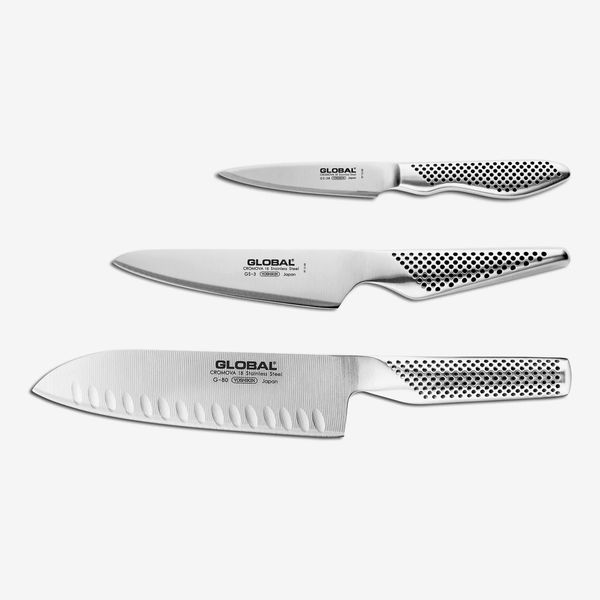

Number of pieces: Three (paring knife, chef’s knife, santoku knife) | Style: Japanese with some European influence
Every other set on this list includes a serrated knife, but if you’re looking to expand your collection without that particular blade, this Global collection fits the bill. (I once found myself in that exact predicament: I already own a serrated blade that I love and find to be plenty for the relatively infrequent tasks it is made for, but wanted a few other straight-edged blades for the high volume of cooking that goes on in my kitchen.) With this configuration, I got a 7-inch chef’s knife (notably, our best overall chef’s knife), a 5-inch utility knife, and a 3.5-inch paring knife. They all hold an ultrasharp edge, are lightweight enough to maneuver with ease but heavy enough to feel in control, and have a comfortable grip. In particular, I reach for the utility knife more than expected. Its size is right between the other two with more of an angled blade. This combination makes it useful for tasks that aren’t so delicate but still require some precision, like cutting into a head of broccoli.

Number of pieces: Three (utility knife, bread knife, chef’s knife) | Style: Japanese with some European influence
This Hedley & Bennett trio comes with a chef’s knife, a long and lean serrated knife and, as with the Global set, a utility knife — another set I recommend if you’re looking to fill in particular holes or round out a current collection. I find the most striking feature of all three to be the weight. The serrated knife feels so light for the size. While I have another artisan Japanese serrated knife in my collection that’s a bit shorter and heavier, this one has become my go-to for slicing through big loaves of bread. The utility knife, which is a bit longer than the Global with a straighter edge, feels nimble in my hand. It works to trim the fat off meat and even slice off fish skin. The look of the knives is sleek, too. They come in green, white, and black, each with brass rivets. Chef Melissa King and Zoya Roya, founder of Fysh Foods, both love the chef’s knife, too, describing it as “well-balanced,” with Roya adding that ing it’s “not too heavy to handle but heavy enough that it still glides through whatever you’re cutting with ease.”
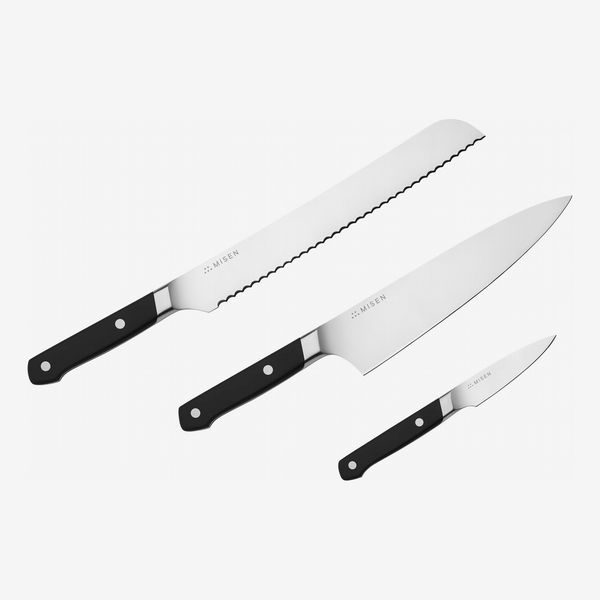
Number of pieces: Three (paring knife, bread knife, chef’s knife) | Style: Japanese and European
For another set with a chef’s knife, serrated knife, and utility knife, consider Misen. “I really like these knives as value buys,” says Jeff Strauss, owner and chef of Jeff’s Table and Oy Bar in Los Angeles. “One of the things knife nerds talk about is steel hardness, and these are on the harder end of bendy, which is a sweet spot.” As he explains it, they’re hard enough to sharpen easily and they hold an edge very well. But they’re not so hard that they move in a funky way that can take some getting used to. You can feel the difference with a super hard blade, and even sometimes break it if you make the wrong movements. “I know a bunch of pro chefs who use these,” he says. “I have six of them. You don’t have to be too, too precious.”
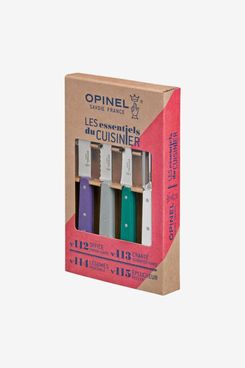
Number of pieces: Four (paring knife, vegetable knife, serrated paring knife, stationary peeler) | Style: European
This isn’t what you would call a traditional knife set: The collection comes with a classic paring knife, two serrated paring knives (one with more pronounced teeth, one with subtler teeth), and a bonus vegetable peeler. Andrew Brady, chef and partner at the Boston-area restaurants Dear Annie and Field and Vine, has several of them in his work kitchens at all times because they’re so versatile. “Smaller knives tend to be made more cheaply,” he says, “but these are sharp.” He calls the dramatically ridged model a “serious workhorse” that’s great for peppers and chilis, garlic, and shallots, or “small foods that still benefit some serious serrated power,” he says. The subtler ridged one, which he uses for more delicate tasks like cutting through tarts and cherry tomatoes, also comes with a hook-like shape at the tip of the knife. That feature is “useful for handheld tasks where you need to get into a piece of food, like cutting the button off a Brussels sprout or the stem off a strawberry,” he says.
• Andrew Brady, chef and partner at Dear Annie and Field and Vine
• Rebecca Firkser, recipe developer and writer
• Erin Gleeson, cookbook author
• Eden Grinshpan, cook and Top Chef Canada host
• Melissa King, chef
• Kiano Moju, culinary producer
• Zoya Roya, founder of Fysh Foods
• Jeff Strauss, owner and chef of Jeff’s Table and Oy Bar
The Strategist is designed to surface the most useful, expert recommendations for things to buy across the vast e-commerce landscape. Some of our latest conquests include the best women’s jeans, rolling luggage, pillows for side sleepers, ultra-flattering pants, and bath towels. We update links when possible, but note that deals can expire and all prices are subject to change.
Every editorial product is independently selected. If you buy something through our links, New York may earn an affiliate commission.


